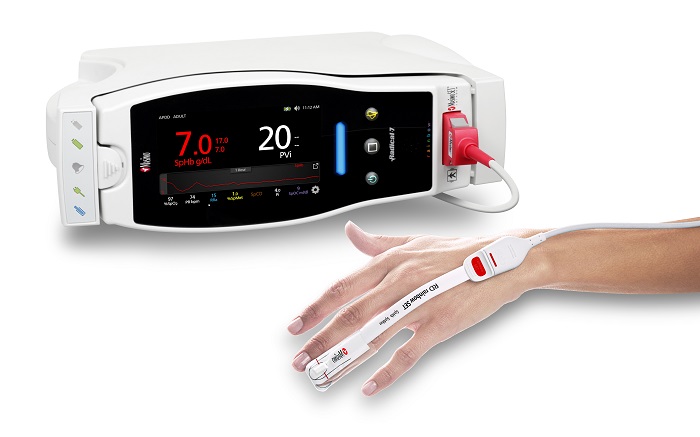Masimo announced the findings of a recently published study in which researchers at Cairo University in Egypt evaluated the accuracy and trending of Masimo noninvasive and continuous hemoglobin (SpHb®), referenced to an invasive laboratory hemoglobin (Lab-Hb) measurement, during acute bleeding and after fluid resuscitation
In the study, Dr. Adel and colleagues sought to investigate the performance of SpHb in different volume statuses and perfusion states. They utilized intraoperative data from 70 patients scheduled for major orthopedic procedures with anticipated major blood loss. SpHb, as well as Masimo PVi® and Pi, were measured using a Masimo Radical-7® Pulse CO-Oximeter®. Lab-Hb was measured using a Beckman Coulter LH 750 analyzer. SpHb and Lab-Hb were recorded at three times – a baseline reading five minutes after endotracheal intubation, after major bleeding, and after fluid resuscitation – resulting in 210 time-matched readings, which were divided into fluid responsive and fluid non-responsive samples and low and high perfusion index samples.
Using Bland-Altman analysis, the researchers found “excellent correlation” between Lab-Hb and SpHb (r=0.938). In addition, they reported “excellent accuracy with moderate levels of agreement,” as noted below, for various sample sets:
Sample set Mean bias Limits of agreement
All 0.01 -1.33 to 1.34 g/dL
Fluid non-responsive -0.08 -1.27 to 1.11 g/dL
Fluid responsive 0.09 -1.36 to 1.54 g/dL
High Pi 0.01 -1.34 to 1.31 g/dL
Low Pi 0.04 -1.31 to 1.39 g/dL
The researchers also noted that polar plot analysis (angular bias of -4°) showed “good trending ability for SpHb as a follow-up monitor.”
The investigators concluded that, “SpHb showed excellent correlation with Lab-Hb in fluid responders, fluid non-responders, low-Pi, and high-Pi states. Despite a favorable mean bias of 0.01 g/dL for SpHb, the relatively wide levels of agreement (-1.3 to 1.3 g/dL) might limit its accuracy. SpHb showed good performance as a trend monitor.”
SpHb is not intended to replace laboratory blood testing. Clinical decisions regarding red blood cell transfusions should be based on the clinician’s judgment considering among other factors: patient condition, continuous SpHb monitoring, and laboratory diagnostic tests using blood samples.
@MasimoInnovates || #Masimo
Reference
1. Adel A, Awada W, Abdelhamid B, Omar H, Dayem O, Hasanin A, and Rady A. Accuracy and trending of noninvasive hemoglobin measurement during different volume and perfusion statuses. J Clin Mon. 2018. https://doi.org/10.1007/s10877-018-0101-z.
About Masimo
Masimo (NASDAQ: MASI) is a global leader in innovative noninvasive monitoring technologies. Our mission is to improve patient outcomes and reduce the cost of care. In 1995, the company debuted Masimo SET® Measure-through Motion and Low Perfusion™ pulse oximetry, which has been shown in multiple studies to significantly reduce false alarms and accurately monitor for true alarms. Masimo SET® has also been shown to help clinicians reduce severe retinopathy of prematurity in neonates,1 improve CCHD screening in newborns,2 and, when used for continuous monitoring with Masimo Patient SafetyNet™* in post-surgical wards, reduce rapid response activations and costs.3,4,5 Masimo SET® is estimated to be used on more than 100 million patients in leading hospitals and other healthcare settings around the world,6 and is the primary pulse oximetry at 17 of the top 20 hospitals listed in the 2017-18 U.S. News and World Report Best Hospitals Honor Roll.7 In 2005, Masimo introduced rainbow® Pulse CO-Oximetry technology, allowing noninvasive and continuous monitoring of blood constituents that previously could only be measured invasively, including total hemoglobin (SpHb®), oxygen content (SpOC™), carboxyhemoglobin (SpCO®), methemoglobin (SpMet®), Pleth Variability Index (PVi®), and more recently, Oxygen Reserve Index (ORi™), in addition to SpO2, pulse rate, and perfusion index (Pi). In 2014, Masimo introduced Root®, an intuitive patient monitoring and connectivity platform with the Masimo Open Connect®(MOC-9®) interface, enabling other companies to augment Root with new features and measurement capabilities. Masimo is also taking an active leadership role in mHealth with products such as the Radius-7® wearable patient monitor, iSpO2® pulse oximeter for smartphones, and the MightySat™ fingertip pulse oximeter. Additional information about Masimo and its products may be found at www.masimo.com. Published clinical studies on Masimo products can be found at www.masimo.com/cpub/clinical-evidence.htm.
ORi has not received FDA 510(k) clearance and is not available for sale in the United States.
*The use of the trademark Patient SafetyNet is under license from University HealthSystem Consortium.
In the study, Dr. Adel and colleagues sought to investigate the performance of SpHb in different volume statuses and perfusion states. They utilized intraoperative data from 70 patients scheduled for major orthopedic procedures with anticipated major blood loss. SpHb, as well as Masimo PVi® and Pi, were measured using a Masimo Radical-7® Pulse CO-Oximeter®. Lab-Hb was measured using a Beckman Coulter LH 750 analyzer. SpHb and Lab-Hb were recorded at three times – a baseline reading five minutes after endotracheal intubation, after major bleeding, and after fluid resuscitation – resulting in 210 time-matched readings, which were divided into fluid responsive and fluid non-responsive samples and low and high perfusion index samples.
Using Bland-Altman analysis, the researchers found “excellent correlation” between Lab-Hb and SpHb (r=0.938). In addition, they reported “excellent accuracy with moderate levels of agreement,” as noted below, for various sample sets:
Sample set Mean bias Limits of agreement
All 0.01 -1.33 to 1.34 g/dL
Fluid non-responsive -0.08 -1.27 to 1.11 g/dL
Fluid responsive 0.09 -1.36 to 1.54 g/dL
High Pi 0.01 -1.34 to 1.31 g/dL
Low Pi 0.04 -1.31 to 1.39 g/dL
The researchers also noted that polar plot analysis (angular bias of -4°) showed “good trending ability for SpHb as a follow-up monitor.”
The investigators concluded that, “SpHb showed excellent correlation with Lab-Hb in fluid responders, fluid non-responders, low-Pi, and high-Pi states. Despite a favorable mean bias of 0.01 g/dL for SpHb, the relatively wide levels of agreement (-1.3 to 1.3 g/dL) might limit its accuracy. SpHb showed good performance as a trend monitor.”
SpHb is not intended to replace laboratory blood testing. Clinical decisions regarding red blood cell transfusions should be based on the clinician’s judgment considering among other factors: patient condition, continuous SpHb monitoring, and laboratory diagnostic tests using blood samples.
@MasimoInnovates || #Masimo
Reference
1. Adel A, Awada W, Abdelhamid B, Omar H, Dayem O, Hasanin A, and Rady A. Accuracy and trending of noninvasive hemoglobin measurement during different volume and perfusion statuses. J Clin Mon. 2018. https://doi.org/10.1007/s10877-018-0101-z.
About Masimo
Masimo (NASDAQ: MASI) is a global leader in innovative noninvasive monitoring technologies. Our mission is to improve patient outcomes and reduce the cost of care. In 1995, the company debuted Masimo SET® Measure-through Motion and Low Perfusion™ pulse oximetry, which has been shown in multiple studies to significantly reduce false alarms and accurately monitor for true alarms. Masimo SET® has also been shown to help clinicians reduce severe retinopathy of prematurity in neonates,1 improve CCHD screening in newborns,2 and, when used for continuous monitoring with Masimo Patient SafetyNet™* in post-surgical wards, reduce rapid response activations and costs.3,4,5 Masimo SET® is estimated to be used on more than 100 million patients in leading hospitals and other healthcare settings around the world,6 and is the primary pulse oximetry at 17 of the top 20 hospitals listed in the 2017-18 U.S. News and World Report Best Hospitals Honor Roll.7 In 2005, Masimo introduced rainbow® Pulse CO-Oximetry technology, allowing noninvasive and continuous monitoring of blood constituents that previously could only be measured invasively, including total hemoglobin (SpHb®), oxygen content (SpOC™), carboxyhemoglobin (SpCO®), methemoglobin (SpMet®), Pleth Variability Index (PVi®), and more recently, Oxygen Reserve Index (ORi™), in addition to SpO2, pulse rate, and perfusion index (Pi). In 2014, Masimo introduced Root®, an intuitive patient monitoring and connectivity platform with the Masimo Open Connect®(MOC-9®) interface, enabling other companies to augment Root with new features and measurement capabilities. Masimo is also taking an active leadership role in mHealth with products such as the Radius-7® wearable patient monitor, iSpO2® pulse oximeter for smartphones, and the MightySat™ fingertip pulse oximeter. Additional information about Masimo and its products may be found at www.masimo.com. Published clinical studies on Masimo products can be found at www.masimo.com/cpub/clinical-evidence.htm.
ORi has not received FDA 510(k) clearance and is not available for sale in the United States.
*The use of the trademark Patient SafetyNet is under license from University HealthSystem Consortium.


















